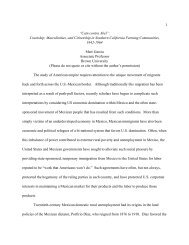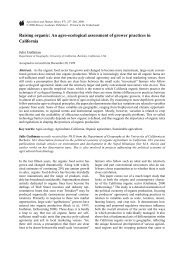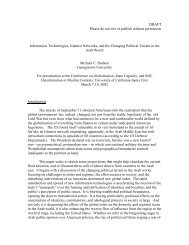The Death of Ramon Gonzalez and the 21st Century Dilemma
The Death of Ramon Gonzalez and the 21st Century Dilemma
The Death of Ramon Gonzalez and the 21st Century Dilemma
Create successful ePaper yourself
Turn your PDF publications into a flip-book with our unique Google optimized e-Paper software.
assassinations carried out by <strong>the</strong> government <strong>and</strong> by private armed gangs <strong>and</strong><br />
paramilitary forces. <strong>The</strong>se actions are one more reason for people to emigrate. xii<br />
As discussed in <strong>the</strong> first edition <strong>of</strong> <strong>The</strong> <strong>Death</strong> <strong>of</strong> <strong>Ramon</strong> <strong>Gonzalez</strong>,<br />
anthropologists Kearney <strong>and</strong> Carole Nagengast had initiated what is now a rapidly<br />
growing literature on “transnational communities” that are built across borders by<br />
emigrants leaving <strong>the</strong> villages <strong>of</strong> Mexico. xiii Formally organized “home-town<br />
associations” <strong>and</strong> “bi-national organizations” <strong>of</strong> Oaxacans work to ensure that some <strong>of</strong><br />
<strong>the</strong> income earned in <strong>the</strong> United States is returned to home villages. In San Jeronimo<br />
Progreso, migrant income apparently is being spent largely on paving streets, but it is<br />
going into o<strong>the</strong>r community improvements as well. In <strong>the</strong> face <strong>of</strong> acrid controversy, <strong>the</strong><br />
town council <strong>of</strong> San Jeronimo used such money to build a large <strong>and</strong> impressive archway<br />
marking <strong>the</strong> turn-<strong>of</strong>f to <strong>the</strong> town.<br />
Bi-national organizations have worked politically to protect migrant rights <strong>and</strong><br />
contribute to streng<strong>the</strong>ning communities on both sides <strong>of</strong> <strong>the</strong> border. <strong>The</strong>y have been able<br />
to win funds beyond those <strong>the</strong>y collect from members. One large bi-national organization<br />
has received more than US$160,000 from U.S.-based foundations to invest in Oaxacan<br />
communities, including projects for water supply <strong>and</strong> experiments in sustainable<br />
agriculture. <strong>The</strong> ability to benefit from remittances is strongly linked to <strong>the</strong> survival <strong>of</strong><br />
traditional forms <strong>and</strong> <strong>the</strong> invention <strong>of</strong> new kinds <strong>of</strong> community organization in <strong>the</strong> home<br />
villages, as well as in <strong>the</strong> migrant networks. xiv<br />
In San Jeronimo Progreso <strong>and</strong> many o<strong>the</strong>r villages, <strong>the</strong> communal organization is<br />
enforcing a tax on emigrants from <strong>the</strong> community. If emigrants do not pay <strong>the</strong> levy, <strong>the</strong><br />
council sometimes padlocks <strong>the</strong>ir homes <strong>and</strong>/or sells <strong>the</strong>ir assets, including l<strong>and</strong>. In San





